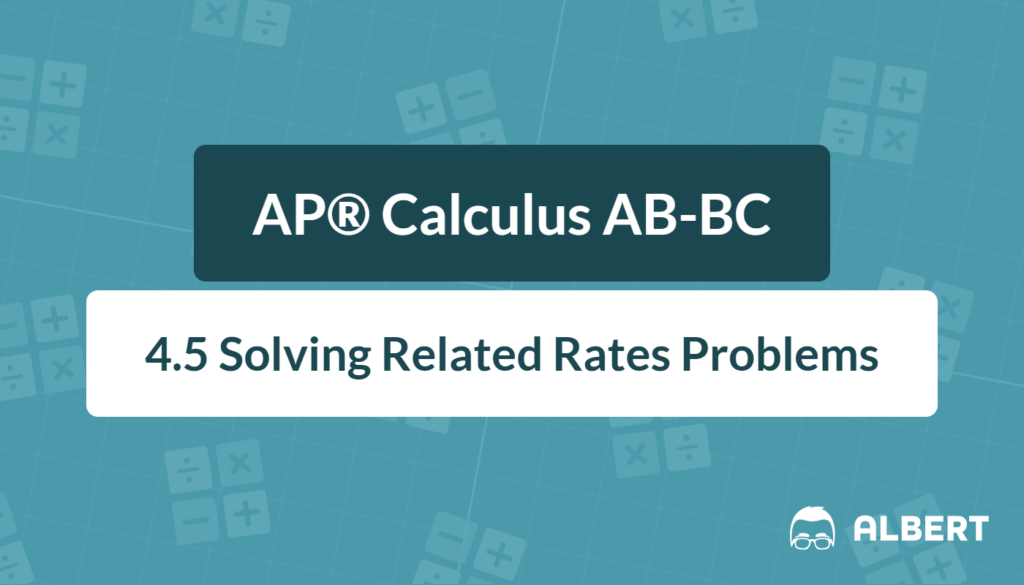Related rates problems ask, “If one quantity changes over time, how quickly does a connected quantity change at the same instant?” Therefore, the topic sits at the heart of differential calculus, appearing in AP® Calculus AB (CHA-3.E.1) and BC alike. Section 4.5 solving related rates problems builds on earlier derivative skills—especially the chain rule and implicit differentiation.
This article first presents a five-step roadmap, then walks through several related rates sample problems. Each idea is paired with a clear example, so every reader can move from confusion to confidence.
What We Review
The Core Strategy for 4.5 Solving Related Rates Problems
Five-Step Roadmap
- Read carefully and assign variables. Label every changing quantity.
- Sketch a diagram. A quick picture often reveals hidden relationships.
- Write an equation that links the variables. Use geometry, trigonometry, or science formulas.
- Differentiate implicitly with respect to time t. Remember that every variable is a function of time.
- Substitute known values, solve, and attach correct units.
Tip: Numbers should enter the work only after differentiating.
Worked Example #1 – “Sliding Ladder”
A 10-ft ladder leans against a vertical wall. The bottom slides away at \dfrac{dx}{dt}=3\text{ ft/s}. How fast is the top descending when the bottom is 6 ft from the wall?
Step 1. Variables
Let
x(t) = distance from wall to ladder’s foot y(t) = height of ladder’s topStep 2. Diagram
Right triangle with legs x and y, hypotenuse 10.
Step 3. Equation
x^{2}+y^{2}=10^{2}Step 4. Differentiate
2x\dfrac{dx}{dt}+2y\dfrac{dy}{dt}=0Divide by 2:
x\dfrac{dx}{dt}+y\dfrac{dy}{dt}=0Step 5. Substitute and solve
When x=6, find y using Pythagorean theorem:
6^{2}+y^{2}=100;\Rightarrow;y=\sqrt{64}=8\text{ ft}Plug in:
6(3)+8\dfrac{dy}{dt}=0 18+8\dfrac{dy}{dt}=0 \dfrac{dy}{dt}=-\dfrac{18}{8}=-2.25\text{ ft/s}The ladder’s top descends at 2.25 ft/s. The negative sign confirms downward motion.
Must-Know Related Rates Formulas
Many questions rely on geometry classics. Memorizing them speeds work, yet understanding when each variable depends on time is even more valuable.
- Circle area: A=\pi r^{2}
- Sphere volume: V=\dfrac{4}{3}\pi r^{3}
- Cone volume: V=\dfrac{1}{3}\pi r^{2}h
- Pythagorean theorem: x^{2}+y^{2}=z^{2}
Notice that r, h, x, and y usually change with time, so their derivatives appear after differentiation.
Worked Example #2 – “Inflating Balloon”
Air is pumped into a spherical balloon at \dfrac{dV}{dt}=100\text{ cm}^{3}/\text{s}. How fast is the radius increasing when r=5\text{ cm}?
Equation: V=\dfrac{4}{3}\pi r^{3}
Differentiate:
\dfrac{dV}{dt}=4\pi r^{2}\dfrac{dr}{dt}Solve for \dfrac{dr}{dt}:
\dfrac{dr}{dt}=\dfrac{1}{4\pi r^{2}}\dfrac{dV}{dt}=\dfrac{100}{4\pi(5)^{2}}=\dfrac{100}{100\pi}= \dfrac{1}{\pi}\text{ cm/s}Therefore, the radius grows at approximately 0.318 cm/s when it is 5 cm wide.
Recognizing When to Use Related Rates (Graph Sense Included)
Verbal Clues
Phrases such as “at what rate,” “how fast,” or “find \dfrac{dy}{dt} when…” immediately signal a related rates question.
Visual Clues
Graphs showing changing slopes or tangent lines also hint that quantities vary with time. For instance, the slope of a height-versus-time curve equals \dfrac{dh}{dt}.
Worked Example #3 – “Filling a Conical Tank”
A water tank is an inverted cone with radius 3 m and height 9 m. Water pours in at \dfrac{dV}{dt}=2\text{ m}^{3}/\text{min}. Find \dfrac{dh}{dt} when the water depth is 4 m.
1. Variables
h(t) = water depth r(t) = surface radius2. Diagram
A smaller cone of water inside the large cone.
3. Relationship between r and h
Similar triangles give \dfrac{r}{h}=\dfrac{3}{9}=\dfrac{1}{3}\Rightarrow r=\dfrac{h}{3}.
4. Volume formula
V=\dfrac{1}{3}\pi r^{2}hSubstitute r: V=\dfrac{1}{3}\pi\left(\dfrac{h}{3}\right)^{2}h=\dfrac{\pi h^{3}}{27}
5. Differentiate
\dfrac{dV}{dt}=\dfrac{\pi}{9}h^{2}\dfrac{dh}{dt}6. Solve when h = 4 m
2=\dfrac{\pi}{9}(4)^{2}\dfrac{dh}{dt};\Longrightarrow;2=\dfrac{16\pi}{9}\dfrac{dh}{dt} \dfrac{dh}{dt}=\dfrac{18}{16\pi}=\dfrac{9}{8\pi}\text{ m/min}\approx0.36\text{ m/min}Tips, Traps, and Unit Checks
- Always track units. Mixing centimeters and meters can triple errors.
- Differentiate first, substitute later. Therefore constants stay constant.
- Express linked variables before differentiating. Example: in the conical tank, write r=\dfrac{h}{3} early.
- Finally, confirm the sign of each answer. A negative rate often signals a quantity is shrinking.
Quick Reference Chart: Key Vocabulary & Definitions
| Term | Meaning in Related Rates Problems |
| Related Rates | Technique of finding an unknown rate by linking it to known rates through an equation. |
| Implicit Differentiation | Differentiating an equation with respect to time when variables are functions of time. |
| \dfrac{dA}{dt}, \dfrac{dV}{dt} | Notation for rate of change of area, volume, etc., with respect to time. |
| Instantaneous Rate | The exact rate at a specific moment, found using derivatives. |
| Chain Rule | The derivative rule that underpins every related-rates calculation: \dfrac{d}{dt}f(g(t))=f'(g(t))\cdot g'(t) |
Conclusion
Mastering 4.5 solving related rates problems boils down to one repeatable method:
- Translate words into variables and a diagram.
- Connect those variables with a solid equation.
- Apply the chain rule through implicit differentiation.
- Substitute, solve, and label units.
With practice, the provided related rates formulas and the worked examples above will turn intimidating word problems into routine exercises. Keep the five-step plan nearby, double-check units, and success on the AP® exam will follow.
Sharpen Your Skills for AP® Calculus AB-BC
Are you preparing for the AP® Calculus exam? We’ve got you covered! Try our review articles designed to help you confidently tackle real-world math problems. You’ll find everything you need to succeed, from quick tips to detailed strategies. Start exploring now!
- 4.4 Introduction to Related Rates
- 4.6 Approximating Values of a Function Using Local Linearity and Linearization
Need help preparing for your AP® Calculus AB-BC exam?
Albert has hundreds of AP® Calculus AB-BC practice questions, free responses, and an AP® Calculus AB-BC practice test to try out.








